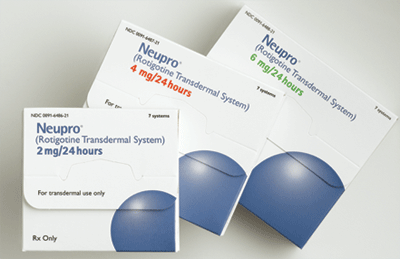Product
Neupro
Approval Date
May 9, 2007
Release Date
June 27, 2007
Companies
UCB and Schwarz Pharma
Class
Dopamine agonist (non-ergot)
Indication
Treatment of patients with early-stage idiopathic Parkinson’s disease who are not receiving concomitant L-dopa.
Active Ingredient
Rotigotine 2mg/24 hours, 4mg/24 hours, 6mg/24 hours; transdermal patch; contains sulfites.
Agency Roster
MC|K Healthcare (consumer and professional)
Marketing Strategy/Execution
UCB and its subsidiary Schwarz Pharma are co-promoting Neurpro. Each firm’s dedicated sales force has begun reaching out to physicians who treat Parkinson’s disease nationwide. In conjunction with the US launch, the companies were also slated to kick off grassroots, public education effort PDAware, aimed to raise the profile of Parkinson’s by highlighting patient experiences and treatment options. Marketers will position Neupro as an effective, once-daily patch for early stage treatment.
The Market
| Anti-parkinson’s US sales ($000s) last 5 years | |
| 2006 |
$1,070,839 |
| 2005 |
$874,954 |
| 2004 |
$808,815 |
| 2003 |
$762,050 |
| 2002 |
$690,317 |
| Source: IMS Health, Oct. 2007 |
|
| Top 5 anti-parkinson’s | ||
| Jan.-July ’07 US sales ($000s) | % sales growth over Jan.-July ‘06 | |
|
REQUIP (GlaxoSmithKline) |
265,623 |
55 |
|
MIRAPEX (Boehringer Ingelheim) |
192,060 |
17 |
|
COMTAN (Novartis) |
47,460 |
8 |
|
STALEVO 100 (Novartis) |
27,734 |
15 |
|
AZILECT (Teva) |
25,899 |
>999 |
| Source: IMS Health, Oct. 2007 |
||
Physician Outlook
Neupro (rotigotine) is a new dopamine receptor agonist for the treatment of Parkinson’s disease. According to our physician research, neurologists anticipate increasing usage over the next six months by 60%, because Neupro is new and in a convenient once-daily patch dosage form. In addition, neurologists and PCPs have unmet needs for products that are better able to slow the progression of early stage symptoms, and Neupro ranked on par with the other two dopamine receptor agonists, Mirapex and Requip.
—Kim Lazarus, VP, category leader, neurology, GfK Market Measures, Oct. 2007
Also in the Pipeline (according to Adis R&D Insights)
Drug: Duodopa
Manufacturer: NeoPharma
Indication: Parkinson’s disease
Active Ingredient: Levodopa/carbidopa intraduodenal
Phase: III
Drug: Lysuride/ Lisuride Sub Q/Lisuride TDS
Manufacturer: Bayer Schering Pharma/axxonis/Prestwick Pharmaceuticals
Indication: Parkinson’s disease
Active Ingredient: Lisuride maleate
Phase: III
Drug: SLV 308/SME 308
Manufacturer: Solvay
Indication : Parkinson’s disease, Depression, Panic Disorder
Active Ingredient: Pardoprunox
Phase: II, III (Parkinson’s Disease)
Drug: Requip/Ropinirole
Manufacturer: GlaxoSmithKline
Active Ingredient: Ropinirole controlled-release
Indication: Parkinson’s disease, Restless legs syndrome
Phase: Preregistration
Source: Wolters Kluwer Health, Oct. 2007
UCBcuts 2,000 jobs, re-tools as a specialty company
Productnews from the 05/15/07 news brief
Pharmacology
Neupro is a transdermal patch containing rotigotine, a D3/D2/D1 dopamine agonist. The mechanism of action of rotigotine in treating Parkinson’s disease may be due to its ability to stimulate D2 receptors in the caudate-putamen.
About 45% of the drug is released within 24 hrs after applying the patch. The drug is detectable in plasma about 3 hours after application, and maximum plasma concentrations are usually reached between 15 and 18 hours post-dose. Steady-state levels are achieved within 2–3 days of daily dosing.
Clinical Trials
Three double-blind placebo-controlled studies were conducted to evaluate the effectiveness of Neupro in treating the signs and symptoms of early-stage idiopathic Parkinson’s disease. Patients were not on other dopamine agonists or L-dopa during the trials. The primary outcome assessment was the change from baseline for the combined scores for part II (activities of daily living) and part III (motor component) of the Unified Parkinson’s Disease Rating Scale (UPDRS).
A dose-response study indicated that statistically significant mean changes reflecting dose-related improvement were seen for the marketed doses of 4mg/24 hrs and 6mg/24 hrs; an 8mg/24 hrs dose had a similar effect as the 6mg/24 hrs dose. In the North American study, patients treated with Neupro had a mean change in the UPDRS from baseline to end of treatment that was statistically significant compared to those treated with placebo.
In a three-arm foreign multinational study that compared Neupro to an active, oral comparator and to placebo, patients treated with Neupro at doses up to 8mg/24 hrs had a mean change in the combined UPDRS from baseline to the end of treatment that was statistically better than those given placebo.
Adverse Reactions
Somnolence (may be sudden), dizziness, GI upset, application site reactions, headache, insomnia, weight change, lab abnormalities; orthostatic hypotension, syncope, hallucinations, intense urges/compulsions, others.
Adults
Apply to clean, dry, intact skin on abdomen, thigh, hip, flank, shoulder, or upper arm. Initial: apply one 2mg/24 hrs patch once daily; may increase weekly by 2mg/24 hrs; max one 6mg/24 hrs patch once daily. Rotate application site (allow 14 days before reapplying to same site). Shave site at least 3 days before application if hairy. Do not cut patch. Avoid abrupt cessation; reduce by 2mg/24 hrs every other day.
Children
Not recommended
Precautions
Avoid external heat sources. Remove patch before cardioversion, MRI. Consider discontinuing if excessive daytime sleepiness or falling asleep during activities occurs. Cardiovascular disease. Conditions aggravated by fluid retention (eg, CHF). Asthma (sulfite sensitivity). Dyskinesia. Severe hepatic impairment. Monitor for melanoma. Pregnancy (Cat.C). Nursing mothers: not recommended.
Interactions
Additive CNS depression with alcohol, CNS depressants. May be antagonized by metoclopramide, antipsychotics.









